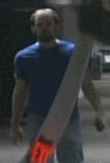|
|
This topic comprises 3 pages: 1 2 3
|
|
Author
|
Topic: A Simplex Shaky Picture
|
|
|
|
|
|
|
|
|
|
|
|
|
|
|
|
|
|
|
Monte L Fullmer
Film God

Posts: 8367
From: Nampa, Idaho, USA
Registered: Nov 2004
|
 posted 02-22-2005 01:56 AM
posted 02-22-2005 01:56 AM




If it's the Mil2000 machines, those have the Century trap and gate assembly, and what can happen(if this is the case and machine that's causing this) is that the gate assembly is adjusted by two taper bolts with 9/64th allen sockets.
What can happen is that the adjustment has worked itself loose, where the band tension will not do any good. One must loosen up those taper bolts and slide in the gate assembly a bit towards the trap, then retighten to see if this cures the vertical jumping-if it's gate and trap related. If this works, make sure that the band tension is back down to "1" for miminual wear.
I've had 2 Mils do this very thing-jumpy pict and the band tension was cranked all the way up.
Now, if it's the older 1050's, there is a stop allen that stops the gate from closing too tight, or it could wiggle itself out to where the gate isn't closing too tight-as above with the Mils.
The stop allen is the allen screw on the other side of the aperture opening on the trap assembly.
How to see if the assembly is closing properly, is to look at the Intermittent shoes and when the gate closes, the shoes should have just completely touched the sprocket-no more nor, no less.
If the shoes have touched the sprocket and the gate has more to close, then the stop allen is in too much. If the shoes aren't even closing around the sprocket, or just one side of the shoes are touching the sprocket, the stop allen is out too far,which isn't allowing the gate to come completely closed to the trap.
If it isn't these above, you could have some turret bearing that have gone bad, or the turret rings are out of adjustment. In the 1050's, the top bearing is on an eccentric shaft whereas the other two are on solid shafts. The top shaft is where one tightens up the turret so there is very gradual play. Loosen up the allen - a 3/32nds and put a 1/8" allen in the front of the bearing, and this will rotate the shaft until when the turret can rotate, but without any play. Also, check the two nylon stop bolts for the turret and see if they're stopping the turret in position when the turret is closing.
These turret tips are probably not related to the vertical problem that is apparent, but it's an area that needs attention as well.
Little helps for you on your jumpy problem.
-good luck .. Monte
| IP: Logged
|
|
|
|
|
|
Michael Schaffer
"Where is the
Boardwalk Hotel?"

Posts: 4143
From: Boston, MA
Registered: Apr 2002
|
 posted 02-22-2005 05:56 AM
posted 02-22-2005 05:56 AM





The white man speaks the truth! Interestingly, in the old Simplex manuals, I don't think it says anything about distance between the pad shoe and the sprocket. But in the PR2000 manual, it says there should be 1 film thickness space. Yes, the gate is different (the one which swings from a bolt on top of the gate), but the principle is the same. Typically, clearance between pad rollers and the other sprockets is set to 2 film thicknesses. That's because unlike the intermittent pad shoe, they are not springed to allow splices to pass through smoothly. Whether you put a piece of film on the intermittent sprocket and adjust the stopping screw so that it just closes, or whether you simply adjust it by feeling so that it just touches the sprocket or is a tiny little bit away from it, doesn't really matter. What's important is that the pad shoe simply holds the film on the sprocket without much pressure. Too much pressure can result in excessive shedding and wear down the intermittent movement prematurely.
After adjusting the gate closure, you will also have to adjust gate band tension. The best tension is just what is needed to keep the film from jumping up and down, not much more. You also need to reset the focus. Often, you still have enough play using the focus adjustment on the lens turret. But you can also reset the lenses by setting the focus adjustment screw to the middle of its travel, losening the screw which tightens down the lens barrel, and moving the lenses into the ideal focus position. Also check out the tips for scope lens adjustments here in the tips section. Finally, check if the stopping screw for the lens turret has worn down, and also the screws which stop the turret in scope or flat position when you rotate it. All these sometimes get loose or wear down, the picture can get a little, but noticeably, out of alignment!
There are a few other really good tips in the manuals. I believe you can view them on www.film-tech.com , or http://www.strong-cinema.com/ , also download and print them! Most of them even have pictures!!
| IP: Logged
|
|
|
|
|
|
|
|
All times are Central (GMT -6:00)
|
This topic comprises 3 pages: 1 2 3
|
Powered by Infopop Corporation
UBB.classicTM
6.3.1.2
The Film-Tech Forums are designed for various members related to the cinema industry to express their opinions, viewpoints and testimonials on various products, services and events based upon speculation, personal knowledge and factual information through use, therefore all views represented here allow no liability upon the publishers of this web site and the owners of said views assume no liability for any ill will resulting from these postings. The posts made here are for educational as well as entertainment purposes and as such anyone viewing this portion of the website must accept these views as statements of the author of that opinion
and agrees to release the authors from any and all liability.
|

 Home
Home
 Products
Products
 Store
Store
 Forum
Forum
 Warehouse
Warehouse
 Contact Us
Contact Us




 Printer-friendly view of this topic
Printer-friendly view of this topic





![[Smile]](smile.gif)







![[Wink]](wink.gif)
![[beer]](graemlins/beer.gif)




